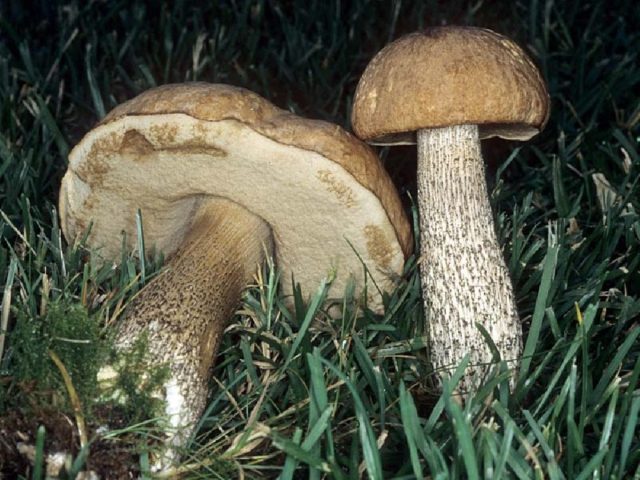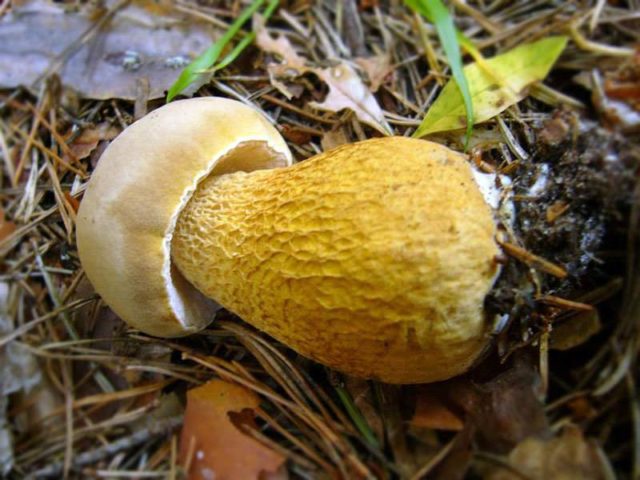Content
White boletus from the Boletaceae family is known as marsh boletus, and in the scientific literature - Boletus holopus, or Leccinum chioeum. In some local dialects they are called “shlyupik” because of their watery nature. White obabkas are an edible tubular species that is widespread throughout the middle zone.
Where do white boletes (marsh boletus) grow?
Marsh boletuses grow under birch trees, on the roots of which a species of mycorrhiza settles; they are distributed throughout the middle zone in Europe and Asia, but are not common.Despite the name “swamp”, they do not grow in the swamps themselves, but they like to appear singly or in loose groups in damp, swampy places, on acidic soils. Expected and most likely habitats of swamp apes:
- damp birch groves;
- on the border of birch woodland and swamp;
- dry peat bogs;
- in the forest among mosses, especially sphagnum, because the species loves dampness and is nourished by the moisture that the moss retains.
Sometimes mushroom pickers report unusual finds: a family of boletus boletuses on a still standing trunk of a rotten birch tree.
The period of appearance of white caps is from the end of May until the first frosts, which begin in various areas at the end of October or November.
What do white women look like?
The boletus boletus, as seen in the photo, is a rather large mushroom with a cap with a diameter of 7 to 12-15 cm. Mushroom pickers testify that there are specimens with a cap width of more than 20 cm. Characteristic features of the appearance of the cap of white caps:
- pillow-shaped or hemispherical shape;
- open even in young specimens of boletus boletuses, and sometimes, in drought, the edges of the cap are slightly bent upward;
- the structure of the fruiting body appears to be hard and leathery;
- the skin is dry to the touch, except during rainy periods;
- the color is light brown in various shades; some mushroom pickers define the color of the cap of the white cap as off-white with a greenish-brown tint as it ages.
Under the cap there is a tubular layer that is perceived as large angular pores. Young mushrooms are distinguished by a light color at the bottom of the cap, while old ones are intensely brown. The mass of spores looks dark ocher, almost brown.
Under the skin of the cap is greenish-white, soft and watery pulp.In older mushrooms it becomes darker - to a white-brown or greenish-brown tone. The smell of swamp fat is weak, as is the taste after cooking.
White caps are perceived as disproportionately developed mushrooms, since the stem in relation to the large and thick cap seems too tall and thin. Features of the swamp-type leg:
- elongated, from 5 to 20 or even 30 cm;
- the shape is cylindrical, straight or curved, since the mushroom often breaks through dense moss;
- the surface is distinctly fibrous, covered with loose scales - whitish in young mushrooms, brown in old ones;
- From afar, the color of the boletus boletus leg is perceived as white-gray.
The legs of white stumps are tough and do not have any attractive aroma or taste, so they are rarely eaten.
Is it possible to eat white boletus mushrooms?
White obabok is edible. Young caps are eaten. The legs are not taken because of their rigid structure. Marsh boletus belongs to the third category of mushrooms in terms of nutritional value. It tastes pretty good when cooked, especially with other flavorful varieties, but it has relatively few valuable nutrients. Obabkas are taken only for the masses.
Taste qualities of mushrooms
Swamp boletus differs from ordinary boletus in its loose pulp, which boils heavily, turns the broth dark and becomes not only ugly to look at, but also completely tasteless. In addition, it is advisable to take only young white ducks for food.It is recommended to cut only caps that are dry to the touch. Marsh boletus is not collected for preparations, because when salted and pickled, the pulp spreads in the liquid and becomes completely unappetizing. Loose pods have few characteristic aromatic compounds, and therefore young specimens are simply placed together with more valuable ones to increase the mass of the dish.
Benefits and harm to the body
Marsh boletus is a low-calorie product: 100 g contains up to 30 kcal. The beneficial properties of the species are based on the fact that the composition contains enough biologically active substances:
- cleanse the body, being natural antioxidants;
- promotes the removal of cholesterol;
- have a general strengthening effect, including increasing immunity;
- improve the hematopoietic function of the body;
- dietary fiber helps normalize intestinal function;
- the presence of phosphoric acid stimulates the functioning of the musculoskeletal system.
Although the species belongs to the third category in terms of nutritional value, the fruiting body of the white cape contains enough minerals and vitamins to have a good effect on the body. But only with moderate use. Mushrooms are recommended for diabetics as a product that lowers blood sugar levels. Their regular consumption is believed to have antiviral, antioxidant and anti-inflammatory effects.
Considering the beneficial properties, it is necessary to remember that boletus is a wild species and should be consumed in moderation. Patients with ulcers and people with intestinal problems should treat dishes made from white obabka with caution.Contraindication is individual intolerance to the product. Marsh boletus, like any other mushrooms, is not recommended for baby food.
False doubles
The white boletus is similar to other species of boletus of the genus Obabok (Leccinum), which are all edible and harmless if cut incorrectly:
- ordinary;
- solid;
- pinkish;
- ash gray;
- white.
All boletus mushrooms, except the boletus boletus, belong to the second category. Therefore, such doubles can be collected. All types of boletus mushrooms have a common feature: the flesh is dense only in young mushrooms, while in old ones it is loose and watery.
Marsh boletus is distinguished by the reaction of the pulp after cutting:
- in some boletuses the flesh may turn slightly pink;
- The white monkey's color does not change.
The false counterpart of the bog moth is a dangerous gall fungus, or mustard. Young mushrooms of a toxic species in shape and color can easily be mistaken for boletus mushrooms, although they grow in mixed forests, on coniferous litter in the shade.
There are differences:
- after cutting, the flesh of the gall mushroom becomes pink;
- the tubular layer under the cap is also pink, and in the caps it is white-gray or cream;
- Bitterweed has a net pattern on its leg.
Collection rules
When collecting white obobkas, remember that:
- according to the photo and description, white boletus grows in small clearings where the sun's rays fall, under birch trees, in damp areas;
- cut young mushrooms;
- do not take specimens with dark spots, wormy and flabby;
- never taste raw mushrooms;
- In rainy weather, the dough quickly deteriorates.
Use
The swamp mushrooms quickly become a viscous mass, unsuitable for consumption, so they are sorted and cooked immediately.Fresh or dried caps are baked and fried, cooked in soups, sauces, used as an ingredient in vegetable stews, but not salted or pickled. Cook for at least 25-30 minutes. The finished mushroom mass sinks to the bottom. Marsh boletuses are fried in sunflower oil. The downside to all of this is that the liquid turns dark when cooked.
Conclusion
White obabki are collected together with other representatives of the genus. Poorly similar to them is toxic bitterling. They go on a “silent” hunt, having carefully learned the species collected in a given area and how to distinguish them.




















